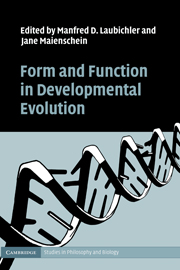Book contents
- Frontmatter
- Contents
- List of figures
- List of tables
- List of contributors
- List of journal abbreviations
- 1 Introduction
- 2 Form and function in Evo Devo: historical and conceptual reflections
- 3 Deducing plant function from organic form: challenges and pitfalls
- 4 Evolution in the light of embryos: seeking the origins of novelties in ontogeny
- 5 A focus on both form and function in examining selection versus constraint
- 6 Innovation and diversity in functional morphology
- 7 The developmental evolution of avian digit homology: an update
- 8 Functional analysis and character transformation
- 9 The nature of constraints
- 10 Toward a mechanistic Evo Devo
- Index
- References
6 - Innovation and diversity in functional morphology
Published online by Cambridge University Press: 28 June 2009
- Frontmatter
- Contents
- List of figures
- List of tables
- List of contributors
- List of journal abbreviations
- 1 Introduction
- 2 Form and function in Evo Devo: historical and conceptual reflections
- 3 Deducing plant function from organic form: challenges and pitfalls
- 4 Evolution in the light of embryos: seeking the origins of novelties in ontogeny
- 5 A focus on both form and function in examining selection versus constraint
- 6 Innovation and diversity in functional morphology
- 7 The developmental evolution of avian digit homology: an update
- 8 Functional analysis and character transformation
- 9 The nature of constraints
- 10 Toward a mechanistic Evo Devo
- Index
- References
Summary
INTRODUCTION
Form and function are so intricately intertwined that it is tempting to view them as nothing more than different viewpoints on the phenotype – one reflecting the other like a mirror. And it is true that some organismal function can be revealed right there in the anatomy. But life is more complex than this, and while form does play a huge role in how structures are used and how they perform, it is not the only factor involved, and, in fact, the mapping of form to function can be surprisingly complex, with considerable subtlety. Emergent mechanical properties of structural systems can often be inferred or directly measured from form, but when it comes to actual function – how the structure is used by the organism – few systems are simple enough and so constrained that function can be completely inferred from form. Thus, while mechanical advantage of muscle acting across a joint can be calculated accurately from morphology, one could not predict the kinematics of locomotion in a quadrupedal vertebrate from limb morphology. The degrees of freedom in motion are too many and ultimately function must be measured in any but the simplest system before insight can be gained into how form influences function. Indeed, much of our intuition of form–function relationships is developed from studying the relationship empirically in one organism and then assuming certain commonalities in making predictions about unstudied organisms. This is not the same as being able to build predictions of function directly from form.
- Type
- Chapter
- Information
- Form and Function in Developmental Evolution , pp. 132 - 152Publisher: Cambridge University PressPrint publication year: 2009
References
- 4
- Cited by



